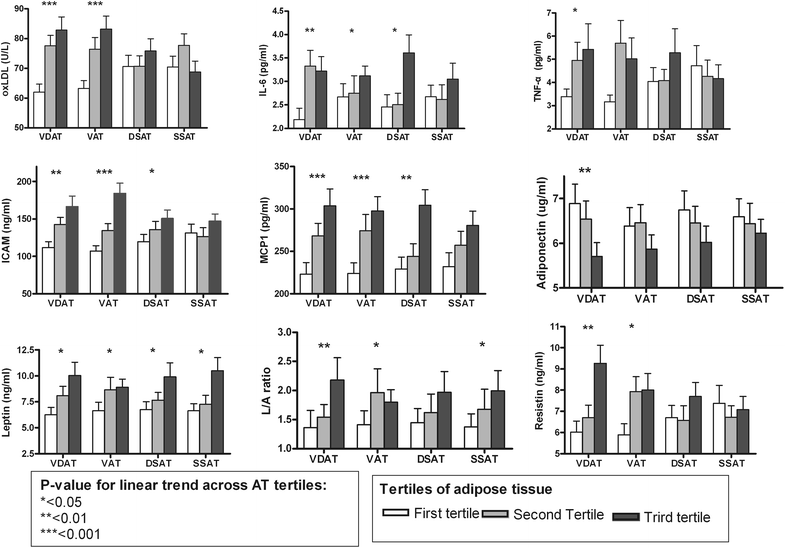Relationship between deep subcutaneous abdominal adipose tissue and metabolic syndrome: a case control study
- PMID: 26877772
- PMCID: PMC4751727
- DOI: 10.1186/s13098-016-0127-7
Relationship between deep subcutaneous abdominal adipose tissue and metabolic syndrome: a case control study
Abstract
Background: The deep subcutaneous adipose tissue (dSAT) is closely related to the obesity-associated complications similarly to the characteristics of visceral adipose tissue (VAT). However, the association between dSAT and metabolic syndrome (MS) is unclear. The purpose of our study was to evaluate the association of distinct abdominal adipose tissue with the cardiometabolic risk factors and MS.
Methods: Abdominal computed tomography (CT) images were obtained in 365 asymptomatic subjects (187 subjects with MS and 178 without MS). The axial images segmented into superficial and deep SAT by manually tracing the fascia superficialis at L4-5 levels. The concentrations of serum inflammatory cytokines and adipokines were also measured.
Results: The MS group had significantly lower adiponectin levels but significantly higher levels of resistin, leptin, tumor necrosis factor-alpha (TNF-α), interleukin-6 (IL-6), intercellular adhesion molecule (ICAM), monocyte chemotactic protein-1 (MCP-1), and oxLDL than the control group (p < 0.05). All inflammatory cytokines and adipokines were associated with the sum of VAT and dSAT areas (VDAT) (P for trend < 0.05), but no significant correlation was found between inflammatory cytokines and sSAT. dSAT was significantly associated with MS in both men and women (OR 2.371; p < 0.001) whereas the ORs between sSAT and MS were not significant (p = 0.597). The age-adjusted ORs between VDAT and MS (OR of 8.359 in men and 3.183 in women, p < 0.001) were higher than those of VAT (OR of 7.941 in men and 2.570 in women, p < 0.05) and dSAT (OR of 2.954 in men and 1.856 in women, p < 0.05).
Conclusions: We demonstrated that dSAT was associated with increased inflammation and oxidative stress, suggesting that dSAT is an important determinant of MS. Therefore, abdominal subcutaneous fat should be considered as two functionally distinct compartments rather than a single entity.
Keywords: Adipocytokine; Deep subcutaneous adipose tissue; Inflammatory cytokine; Metabolic syndrome; Superficial subcutaneous adipose tissue; Visceral adipose tissue.
Figures



Similar articles
-
Deep subcutaneous adipose tissue: a distinct abdominal adipose depot.Obesity (Silver Spring). 2007 Aug;15(8):1933-43. doi: 10.1038/oby.2007.231. Obesity (Silver Spring). 2007. PMID: 17712110
-
Contributions of total body fat, abdominal subcutaneous adipose tissue compartments, and visceral adipose tissue to the metabolic complications of obesity.Metabolism. 2001 Apr;50(4):425-35. doi: 10.1053/meta.2001.21693. Metabolism. 2001. PMID: 11288037 Clinical Trial.
-
Obesity modifies expression profiles of metabolic markers in superficial and deep subcutaneous abdominal adipose tissue depots.Endocrine. 2014 May;46(1):99-106. doi: 10.1007/s12020-013-0040-x. Epub 2013 Sep 13. Endocrine. 2014. PMID: 24030694
-
The origin and purpose of layers of subcutaneous adipose tissue in pigs and man.Horm Mol Biol Clin Investig. 2018 Mar 16;33(1). doi: 10.1515/hmbci-2018-0001. Horm Mol Biol Clin Investig. 2018. PMID: 29547390 Review.
-
Depot-specific hormonal characteristics of subcutaneous and visceral adipose tissue and their relation to the metabolic syndrome.Horm Metab Res. 2002 Nov-Dec;34(11-12):616-21. doi: 10.1055/s-2002-38256. Horm Metab Res. 2002. PMID: 12660870 Review.
Cited by
-
Sex-specific association of visceral and subcutaneous adipose tissue volumes with systemic inflammation and innate immune cells in people living with obesity.Int J Obes (Lond). 2024 Apr;48(4):523-532. doi: 10.1038/s41366-023-01444-9. Epub 2023 Dec 22. Int J Obes (Lond). 2024. PMID: 38135702
-
Inflammatory Response in the CNS: Friend or Foe?Mol Neurobiol. 2017 Dec;54(10):8071-8089. doi: 10.1007/s12035-016-0297-1. Epub 2016 Nov 26. Mol Neurobiol. 2017. PMID: 27889895 Free PMC article. Review.
-
The Effect of VASER Abdominal Liposuction on Metabolic Profile in Overweight Males.Am J Mens Health. 2017 Mar;11(2):284-293. doi: 10.1177/1557988316674841. Epub 2016 Oct 22. Am J Mens Health. 2017. PMID: 27756865 Free PMC article.
-
The Multifunctionality of CD36 in Diabetes Mellitus and Its Complications-Update in Pathogenesis, Treatment and Monitoring.Cells. 2020 Aug 11;9(8):1877. doi: 10.3390/cells9081877. Cells. 2020. PMID: 32796572 Free PMC article. Review.
-
HIV-1 Viral Protein R Couples Metabolic Inflexibility With White Adipose Tissue Thermogenesis.Diabetes. 2021 Sep;70(9):2014-2025. doi: 10.2337/db20-0888. Epub 2021 Jul 7. Diabetes. 2021. PMID: 34233931 Free PMC article.
References
-
- Carr DB, Utzschneider KM, Hull RL, Kodama K, Retzlaff BM, Brunzell JD, et al. Intra-abdominal fat is a major determinant of the National Cholesterol Education Program Adult Treatment Panel III criteria for the metabolic syndrome. Diabetes. 2004;53:2087–2094. doi: 10.2337/diabetes.53.8.2087. - DOI - PubMed
LinkOut - more resources
Full Text Sources
Other Literature Sources
Research Materials
Miscellaneous

